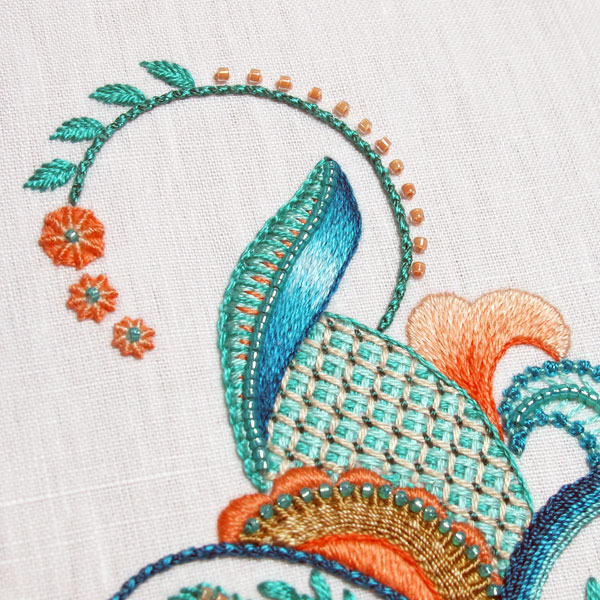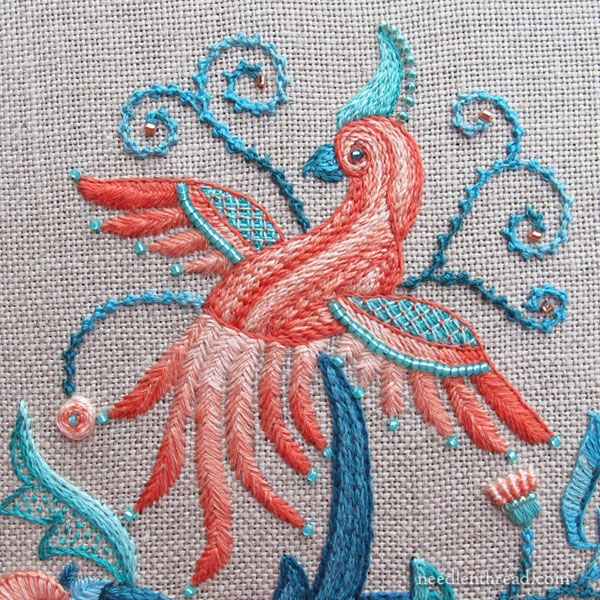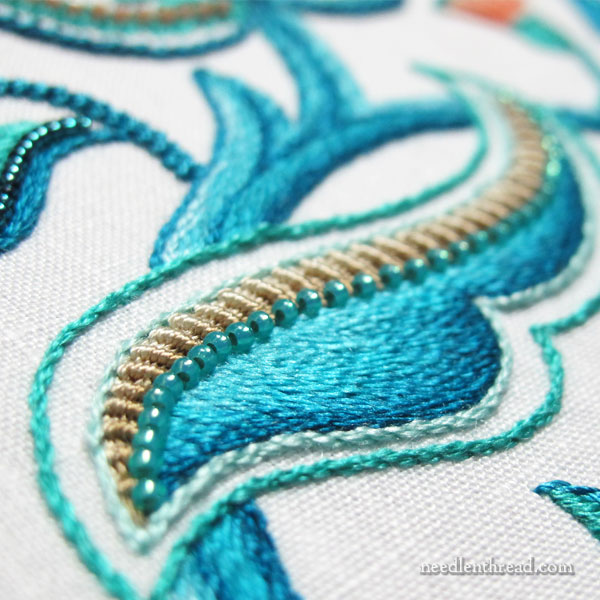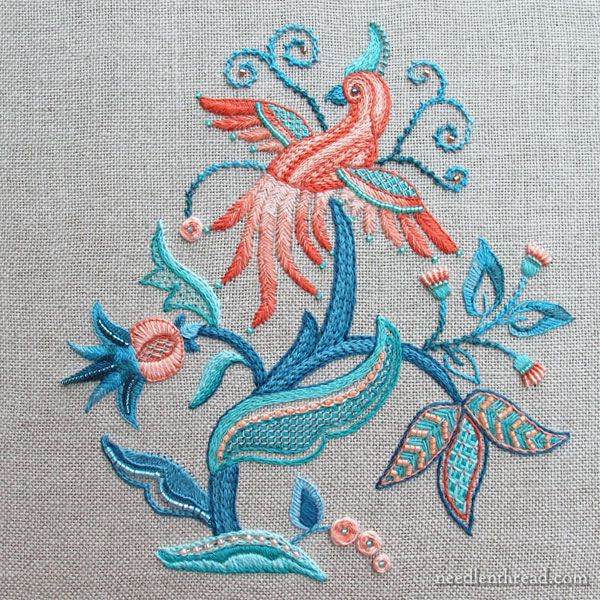Something Jacobean-ish must’ve been rumbling about in the embroidery world in the last month or so.
I always surmise there’s a workshop or a new kit out or a new article or tutorial out there on a specific subject, when I suddenly get an influx of multiple requests for more information (or tips, or tutorials, or instructions) on that particular technique or topic.
I’ve had a number of emails lately requesting tutorials for Jacobean embroidery. Here’s one question (used with the author’s permission):
I’m doing Jacobean embroidery and I’m struggling with the instructions. Can you do some tutorials on Jacobean embroidery, or do you know of a book with illustrations or diagrams?
The reason this is a difficult question is that “Jacobean embroidery” is not a technique. We’ve talked about this before on Needle ‘n Thread, but the topic is buried a bit. So I thought I’d dig it up here.

The project above is from a design I titled Jacobean Sea and it’s titled this because the style is a spin-off of the Jacobean style of design that was popular at the beginning of the 17th century, around the time of King James I of England (“Jacobus” being “James” in Latin).
The term “Jacobean” refers to an era of history. “Jacobean” embroidery is a style of design associated with that era, but not a technique in embroidery.
The style is typified in embroidery by stylized leaves, vines, flourishes, animals, tree of life designs, and the like. We often associate traditional crewel embroidery with Jacobean design, but the Jacobean design style is not limited to crewel embroidery, just as crewel embroidery is not limited to Jacobean design.
Any embroidery technique, any embroidery stitches, and any fabrics and fibers can be used to embroider a Jacobean design, because it’s a design style. It’s not a technique that requires specific stitches, let alone fibers or fabrics, in order to be “Jacobean.”
It’s More than Jacobean
Perhaps one of the best resource that will help you get an idea of the design style for “Jacobean embroidery” is a book titled Jacobean Embroidery: It’s Forms & Fillings (Project Gutenberg link) by Ada Wentworth Fitzwilliam and A. F. Morris Hands.
While it seems, from the title, that the book implies that these are the forms and fillings used in Jacobean embroidery (as if it is a technique), the point of the book is to offer historical examples that typify the embroidery of designs in that style from that era. It’s not a technique book. It’s a design book.
Read the introduction of the book, and you’ll see that the book is about an artistic style, rather than an embroidery technique.
Interestingly, you’ll learn in the introduction that the design elements that we think of as Jacobean are not necessarily “Jacobean,” as referring to that specific era of history. Like all art and design, the elements we associate with Jacobean embroidery come from the developing history of art and design over centuries and from various cultural influences. That’s how artistic styles develop: they build on what has come before.
In fact, slavish imitation of what has come before without advancing new ideas, styles, techniques, materials, and so forth would bog us down in a rather stagnant morass of Artistic Nothingness.
Fortunately, we humans innovate. But we innovate using what has come before us, the art that has influenced and inspired us, mixed with who we are, what we know, and what influences us now.

And so a needlework designer today might take some stylistic elements of Jacobean design, adapt them, interpret them in colors, stitches, fibers, fabrics, and embellishments that may have never been used during the first quarter of the 17th century, but still call the piece “Jacobean” because the influence of that design style is evident in the design.
Embroidery, like any art, changes and shifts from era to era, based on what’s going on in art, design, tastes, philosophy, politics, religion, culture, economics, manufacturing, and so on and so on and so on – all the things that influence people and how they think and what they do – their outlooks and attitudes, their interests, their pursuits. All the elements of life serve to influence the development of art.

And so, a design style is just that – it’s a style.
It’s likely that we can look at something that’s called “Jacobean” and recognize the influence of Jacobean design on it.
But we wouldn’t say, “Hey, that’s a Jacobean design; therefore it must be embroidered with only these stitches, in only these fibers, on only this cloth, or it can’t be called Jacobean.”
That wouldn’t really make sense.

Besides giving me the opportunity to briefly resurrect Jacobean Sea (coming out as a kit some day) and Jacobean Bird (you’d think I’d come up with a more inventive name for her), I hope this ramble has helped clarify (?!?!) the difference between style and technique.
The Practical Upshot
If you’re working a piece of Jacobean embroidery and you’re confused about instruction, just look up the names of the embroidery stitches or techniques being used. They’re likely not any different from the same stitches with the same names used to embroider any style of design.
A chain stitch is a chain stitch is a chain stitch, after all, whether you’re embroidering a piece of Jacobean fantasy or a piece of abstract cubism.
The end.
(Aren’t you glad?)
Have a great weekend!







Love your flamboyant bird, can’t wait for it to come out;either kit or just pattern and stitches. Hurry up, times a wasting!!
I suspect there has been a flurry of inquiries because crewelworkco just had a sale on some printed linens that were seconds but they didn’t come with stitch instruction or color map.
Hi, Mary.
I have several embroidery kits (very old) that are crewel embroidery with lots of wool. I find that I’m allergic to wool, so I’m looking for alternatives. I see that this beautiful work is not wool, and I’m wondering about substituting cotton threads. I would prefer not to use floss or floche as it would take forever to complete these projects. Is perle cotton an acceptable substitute for the wool?
Thanks, and I always love your work and your tips. You’re the best resource for embroidery nuts like me.
Carol
Well, there’s no reason why you can’t use perle cotton, but the thread does have a different texture, and if you are doing any soft shading in the crewel work, perle cotton presents a problem for that, because it’s such a tightly twisted thread. You could use several strands (like, 4 or even 6) of regular stranded cotton for a better effect, I think, than what you’d get with perle for those types of techniques, but for everything else, there’s no reason why you can’t use perle cotton.
I love your post about Jacobean embroidery. My very first purchased kit was a small crewel pincushion with floral motif. I loved learning all of the new-to-me stitches. Thank you, Mary, for rekindling an old love.
Mary Gertrude is lovely. Do you have her pattern to share? I’d love to stitch her.
Glad you like her! When Jacobean Sea is released, she’ll be part of it as a variation.
Is there a possibility that this design and others, ie Jacobsen white on blue could be released as a pet enabling your overseas followers to enjoy your work?
It will be!
Jacobean Style has been a favorite ever since the Mid 1970’s when I did The Tree of Life. It is still my favorite piece. It was a stamped linen design. Not a kit. I bought my own crewel thread(can’t find that brand anymore) and stitches from a pattern book. I wish I could find a way to purchase it again but have never been able to find it. I found the original design after many years, in a book called Heritage Embroidery by Elsa Williams I ordered through Amazon, 2016 . The black and white photo in the book said the Tree of Life was designed by Louise Chrimes.
Thanks for sharing your post.
Style versus Technique is something I have wrestled with for … well forever. “Embroidery styles” is a pet project of mine.
I have come to the conlusion that apart from Bayeux Work, there are almost no defining types of embroidery that are purely technique (and that’s only true because of the Icelandic Altar Frontals!) … maybe shadow work. Everything else is made up of a variety of techniques. Do you think this is a valid assumption? Do I need to do deeper dives? (I love a good research project!) Am I missing more post-Jacobean or non-European techniques/ styles?
Delightful entry as always!
I love it! A chain stitch is a chain stitch is a chain stitch. I do a lot of product reviews as part of the Amazon Vine program. I do a lot of reviews in the arts and crafts department. I see so many items such as, embroidery kits being put out by people who are clueless about what they are calling things. I have tried to give some gentle guidance to some sellers (mostly Chinese) and explain to them that they can’t use keywords like ‘cross stitch’ when the kit doesn’t have a single cross stitch in it. One person who took me up on my suggestions, said that all the others were calling their kits cross stitch so he was just following the crowd. Most however don’t acknowledge anything that I have to say so I turn them into Amazon for having incorrect info in their listing.
I ran into another kit the other day where they called the simple lazy Daisy stitch a Chrysanthemum stitch, a French knot a French Bean stitch, I can’t remember what they called the bullion stitch but it was weird. I have been doing hand embroidery off an on for over 50 years at this point, (and never as good as yours!) and I have read and studied embroidery stitch books including the RSN Book of Embroidery and I have never seen stitches called that. Perhaps in another part of the world, okay. But a lazy daisy stitch is still a lazy daisy stitch. A French knot will always be a French knot. A chain stitch will always be a chain stitch.
I isn’t just embroidery that has this problem. I remember years ago driving to work with PBS radio on a a girl was doing a commentary of some sort on poetry. She so slaughtered the pronunciation of the word poem over and over that I don’t think that any of us listening paid any attention to what she had to say and sure enough the next week a listener commented on that very fact. She was trying to set herself up so much as a poetry expert that she seemed to feel she could do a new spin on how to pronounce the word poem. Something, I as a college graduate, had never heard and other listeners had never heard. It was just weird.
We now have so many ways to double check content and the names for things, that there is no reason to be calling an embroidery kit a cross stitch kit when it isn’t. Or to be calling stitches by the incorrect name. And there are plenty of sources for info on Jacobean embroidery. We live in a gold mine of information is we only start digging for it.
Sorry to go off on such a tangent!
LOL! I’ve had similar rants myself, Gail!
I’ve heard a strange pronunciation of “poem” all my life. My mother always pronounced “poem” as “poym” (as in “poy” – rhymes with “boy” – with an m at the end) – and so did her sisters and several other older folks we knew, where lived for a while down South. My mother was raised in the South, so we always chalked it up to being a Southern pronunciation or colloquialism of some sort. But it was always a source of merriment when mom would say it. It made use laugh! I still chuckle when I think about it. But I admit, if I were at a lecture and I heard an academic pronounce it that way, it would likely rub me the wrong way.
I’ve never heard of French bean stitch (!!!!) for French knot, but I have heard of “chrysanthemum stitch” for what we know as daisy stitch or detached chain stitch. It shows up on a very popular Instagram account coming out of China, the purpose of which is to sell very cheap embroidery kits to a Western audience. Whenever they demonstrate a detached chain (daisy) stitch, they call it a “chrysanthemum stitch” – and I think this has to do with the culture. The chrysanthemum is likely more prevalent than the daisy in everyday speech there, or the translation works out similarly, and they simply aren’t aware of the difference in the terminology for the audience they’re selling to.
I am still chuckling about “poem.” And hearing in my head my mother saying “poym”!
Mary,
There must be two of you because there’s no chance a single person could do all you do. You must have elves!
Now — after the flattery, I have a question: did you ever come up with a pdf pattern or kit for Jacobean Sea? I keep returning to your photos of it to bask in its glory, but what I really want is a chance to make it myself.
So….more flattery: your photography skills and writing skills are scintillating too. You’re a star!!
Hi, Christine – Sorry about the delay in reply to this. We actually have this project (Jacobean Sea) kitted up to sell here on the website, but I have not yet finished the instructions. That is on the top of my list at the beginning of the New Year (2023). Fingers crossed!
I love this part:
“In fact, slavish imitation of what has come before without advancing new ideas, styles, techniques, materials, and so forth would bog us down in a rather stagnant morass of Artistic Nothingness.”
I get so much flack in my Japanese embroidery for trying new color combinations or using different techniques together, but I really believe that innovation is essential to art. There’s a lot to learn from the past, but you also have to do something different sometimes, put your own stamp on it.
Can’t wait for the Jacobean sea kit to come out!
What a lovely and helpful article! Thank you.
In the 1970’s my aunt loved to do crewel work and I thought her Jacobean pieces were beautiful. I loved the bold colors and stitches used to fill leaves and petals, creating interesting textures. Thank you for explaining it is a style not a technique. I hope to find time to work on a piece for myself.
These look wonderful. Have the patterns been made available for sale? If so, please let me know. Thanks yoU!!